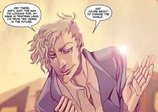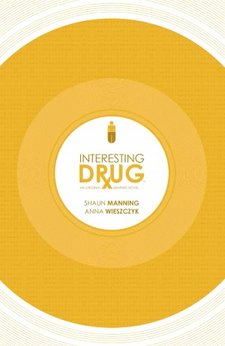Shaun Manning writes novellas, marketing plans for the University of Michigan Press, theatrical productions, work for BBC Radio… and comics. Lots of comics. These include the new graphic novel, Interesting Drug, which was published by Archaia/Boom! Studios to excellent reviews including praise from Comic Book Resources and Broken Frontier.
Interesting Drug takes one of the classic science fiction/fantasy conceits and gives it a new spin. Andrew Smith, a brilliant but unambitious college dropout, meets Tristram Lang, a handsome and charming man who is self-confident to the point of cocksure. Tristram claims to be from ten years in the future, when Andrew has invented a way to make time travel possible, and he’s come back to make sure Andrew succeeds. To his own surprise, Andrew does develop Chro-Noz — a drug that rewires your consciousness to send you back through your timeline. His joy at this discovery is short-lived, for the world becomes addicted to Chro-Noz (and its nostalgia), outpacing contemporary drugs like cocaine or heroin. Andrew, now an unwilling criminal mastermind, discovers that Tristram knows more about time travel than he tells…
Shaun Manning very graciously spoke with me about the challenges of forging a unique addition to the canon of time travel literature.
CREATING TIME TRAVEL
ANDREW ROSTAN: How did you come up with the idea that time travel could be organic as opposed to technological?
SHAUN MANNING: In Grant Morrison’s The Invisibles, there’s an idea that all of time exists simultaneously but we can only see our way through it in a straight line, in one direction. If that’s true (and I’m not going to commit to saying it is), then a person’s entire life should be present within him or herself; there should be a natural way to access it, something that works with the body’s chemistry, or something that’s already there in the body. So, drugs.
AR: What sort of research did you do, and based on that research, what would you imagine the chances are that time travel via this method could be possible?
SM: As to the first bit, I was more concerned with “does this make sense” than “is this physically possible?” I asked friends who are pharmacists and some who, I guess, have some familiarity with pharmacology, how this would work if it was going to work. What would it mean? What, exactly, would it affect? I had to make sure it made sense. People who like sci-fi, who like time travel, are smart; I wanted to know enough to not make a stupid mistake and then let my characters move the story. But yeah, based on my conversations we’re not terribly close to developing this drug. But as to whether there could be some way to time travel ‘organically,’ if time really is simultaneous I don’t see why not.
CREATING THE BOOK
AR: How did you keep the timeline straight and try to avoid paradox?
SM: I had a very good editor. No, it’s something I had to pay very careful attention to, keep track of who is doing what, where, and when. I kept some notes, mostly just a few lines about who could and could not do certain things, and how, but big complex ensemble things are something I enjoy, too. There were details that nearly tripped me up for other reasons, though: Present day, Young Tristram is established as being 15 years old; the time that elapsed between the time I wrote the script and the time the book was published pushed his likely birthdate and thus his earliest possible time travel date forward by quite a bit.
AR: Anna Wieszczyk’s art is really perfect for the story, like something out of the deepest realms of the extracted consciousness, living and warmly human but otherworldly. What was it like collaborating with someone in Poland? Did she understand the story well, and did things ever get temporarily lost in translation?
 SM: You know, it’s been surprisingly smooth. She’s either very comfortable in English or is using a phenomenal translation program. We’ve never spoken by phone/Skype, as I know a lot of writer/artist teams do, and that probably is down to language difference.
SM: You know, it’s been surprisingly smooth. She’s either very comfortable in English or is using a phenomenal translation program. We’ve never spoken by phone/Skype, as I know a lot of writer/artist teams do, and that probably is down to language difference.
Anna’s work is great. She knows what she’s doing. The few times I have asked for changes it’s largely been down to needing the characters positioned a certain way, or shifting small details; the sort of thing that might crop up for any artist/writer pair. More often than not, she gives me something I didn’t know I was looking for in a page; better than expected.
CHARACTERS
AR: One thing I loved most is that you take such a departure from Back to the Future, Primer, and other such tales. Interesting Drug has more in common with stories such as Henry James’s “The Sense of the Past,” Jack Finney’s “Time and Again,” and Richard Matheson’s “Somewhere in Time” in which time travel is not accomplished with technology. Instead, it happens through deep concentration and mental fortitude: in my opinion, the worse possible way. Not that I necessarily dislike those stories, but “travel through time just by thinking about it” is even more wishful thinking than the most outrageous sci-fi and fantasy conceits.
SM: (Laughs)
AR: Your conception is one of the best ways. But what you do have in common with James, Finney, and Matheson is that you are far more interested in the characters and their emotional reactions and motivations for traveling. How did you create the emotional content, and what about the themes resonated with you the most?
SM: Emotional stuff I think comes natural in a story like this — it’s what’s interesting to me. Why would someone take this drug? Well, why wouldn’t they? But then what are the consequences? I mean, the high school hero obsessed with his glory days is a bit of a stereotype, but everybody has ‘what ifs.’ I think if you could literally, physically experience them, to find out, that’s incredibly powerful. And incredibly addictive. There is only one character in the book, Andrew’s friend Leilani, who doesn’t use Chro-Noz. I didn’t make a big thing of her not taking it; I just wanted it there in the background that it is possible to avoid temptation. She’s a failed actress; there are certainly moments she might want to revisit. But whether it’s a moral or ethical aversion, or something else, we don’t see.
AR: Finally, who was the easiest character to write… the one closest to Shaun Manning if he was offered the chance to time travel… and who took the most effort?
 SM: None of them were explicitly based on people I know, but they’re all very much inspired by “people I know” in aggregate. The way they interact is a lot like talking with my friends. They’re clever, but not Warren Ellis-level, every line is a zinger clever; they tell jokes that don’t work and dig each other up about them. Tristram was a bit harder just in that he’s got to be incredibly charismatic, and utterly deranged. What motivates him is, I think, an extension of his successes–he wants more, and fully believes he can get it. It’s possibly the most abstract motivation, but it’s actually one I identify with quite a bit, if I’m honest.
SM: None of them were explicitly based on people I know, but they’re all very much inspired by “people I know” in aggregate. The way they interact is a lot like talking with my friends. They’re clever, but not Warren Ellis-level, every line is a zinger clever; they tell jokes that don’t work and dig each other up about them. Tristram was a bit harder just in that he’s got to be incredibly charismatic, and utterly deranged. What motivates him is, I think, an extension of his successes–he wants more, and fully believes he can get it. It’s possibly the most abstract motivation, but it’s actually one I identify with quite a bit, if I’m honest.






